Nationals Ace In The Hole: Scherzer or Strasburg?

The Washington Nationals have a pair of aces in Max Scherzer and Stephen Strasburg, and one of them might help your 2019 contender.
In case it wasn’t obvious before the Broken Nose Game on Thursday night – the Washington Nationals are not trading Max Scherzer.
There’s a legitimate question as to whether or not they’ll sell at all. Mike Rizzo does not like giving up on a season, and their internal messaging is clear: this season is not over.
The fact is, the Nationals love Max, and if he finishes out the remaining two years of his contract in a Nationals uniform, he likely becomes the first player to enter the Hall of Fame with a Curly W on his cap.
Go to any ballpark in the majors and there are flags with retired numbers, statues of iconic greats, reminders of franchise highs that both add to the ambiance of the ballpark experience and help animate a fanbase. The Nationals have the youngest fanbase in the majors at only 15-years-old. It can’t even drive yet.
Cubs fans know who they are. Red Sox fans have a clear sense of their identity. DC’s fanbase is still growing up. Without much history, there are very few iconic moments/victories/star players to help galvanize an already-transient fanbase. These fans need a role model.
So while Scherzer’s entering the Hall wearing a Nationals cap may not mean much to you – or to individual fans even in DC – his potential induction provides tremendous value to ownership and the eventual value of the franchise.
The Athletic’s Ken Rosenthal already closed the book on this debate when he printed his quote from Rizzo:
“I’ve never been closer to a player in my career. I drafted him in Arizona. I watched him grow up. We went hard after him (in free agency). We made him a promise that if you’re signing for seven years and you’re deferring all this money to help us win championships, we’re going to do everything we can to win.”
Does that sound like someone positioning to move his ace? If he’s pandering, he’s exceptionally adept at it.
The one counterpoint would be that Scherzer locks into 10-and-5 rights at the end of this season, so if there were a time to ship him out for an Anthony-Davis-style bounty of prospects, this would be the year.
But the Nationals have another ace on their staff that prospective buyers should be targeting instead: Stephen Strasburg.
Frankly, due to the confluence of three particular mitigating factors, I don’t think the general public understands how dominant Strasburg’s been since the Nats drafted him first overall out of San Diego State in the 2009 draft.
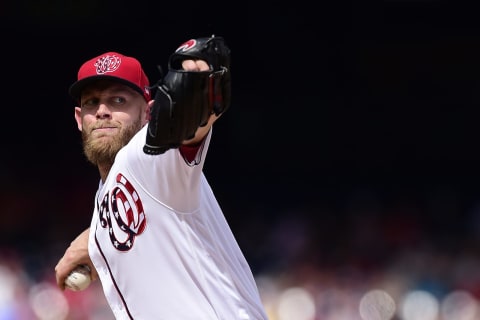
A Word on Stephen Strasburg
The fanfare over Strasburg’s rapid ascendance to the Washington rotation was immediately overshadowed by the drafting of uber-prospect Bryce Harper (Strasburg’s MLB debut actually came the day after Harper was drafted). Harper wouldn’t make it to the majors until 2012, but Strasburg’s star never came to eclipse that of his younger counterpart.
Then there’s the fact that Strasburg’s never really gotten to head his own rotation. He claimed ace status from Gio Gonzalez and Jordan Zimmerman in 2014, but after losing his only playoff start 2-3 and lasting only 5 innings (1 earned run), the Nats immediately went out and gave Scherzer $210MM to steer the ship, relegating Strasburg ever since to first mate status.
The last issue is the only one that’s performance related, and I say “related” because it’s not about his actual performance – it’s about his durability.
After losing his sophomore season to Tommy John surgery, Rizzo chose to cap his innings limit at 160 in 2012 regardless of playoff positioning, robbing Strasburg of the opportunity to shine in the postseason, where players have the best chance of cementing their status.
It’s extremely difficult to shake a public label, and Rizzo’s protection of Strasburg – right or wrong – stuck Strasburg with the enduring stink of fragility. Rizzo’s efforts to keep him from the canon of fire-hurlers with glass arms cemented the public’s perception of him as that very thing.
Now, there is some credence to the perception of Strasburg’s fragility. All in all, he’s taken 11 trips to the injured list in his 10 years in the majors, only once surpassing the 200-inning mark.
Of course, 200 innings is no longer the benchmark it once was, and in the 7 seasons since his lost year in 2012, he has taken between 22 and 34 turns a year, averaging 27 starts and 163 innings per year. He misses maybe 5 starts a season, but when he’s healthy, he averages more than 6 innings per start.
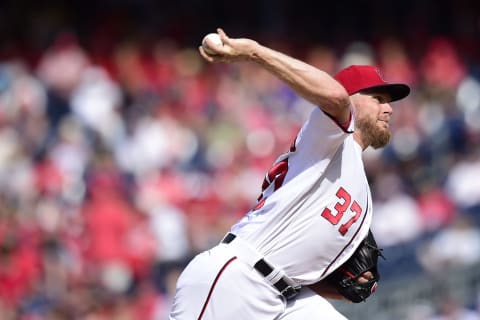
Don’t Underestimate Stras
Here are a few more numbers prospective buyers should know: Strasburg averages 10.6 K/9 for his career. His career FIP is a gold-standard 2.94, and this season he became the fastest pitcher – ever – to reach 1500 career K’s.
No, he won’t charm your socks off, and yes, he misses a start here or there, but the reward is worth the risk. He’s one of a handful of pitchers with the potential to power a team through a postseason series.
Which should already be a bullet point on his resume. In the midst of Washington’s playoff disappointments and 2012’s Restgate, Strasburg’s dominance over the defending champion Cubs in 2017 gets swept under the rug.
Make no mistake: he was an ace in this series, going 14 innings of playoff baseball without surrendering an earned run. The Cubs total offense in the 2017 NLDS against Strasburg amounted to just 5 singles, 1 double, and 3 walks.
In two starts, he struck out 22 Cubs in 14 innings and pitched to a 0.00 ERA. He went 1-1, giving up two unearned runs that basically amounted to an error and back-to-back singles by Kris Bryant and Anthony Rizzo. But the “proof is in the pudding” dictum lives on in playoff baseball, so Strasburg’s heroics in Game Four don’t exist in our memory. Only Game Five remains, and the Nationals lost that game.
A mid-season trade would give Strasburg the opportunity to rewrite the script.
As for the Nationals, they remain star-studded with – at the very least – a transcendent superstar on both sides of the ball in Scherzer and Juan Soto. But an early-season injury to Trea Turner and Trevor Rosenthal‘s bizarro implosion revealed the degree to which the depth of the upper reaches of the organization is lacking. They’re eight games behind the Braves.
If the Nats cleave Strasburg from the docket, they’ll be in an excellent buying position for next season to re-load (Gerrit Cole, Zack Wheeler, Madison Bumgarner), while the prospects returned can fill in some of the empty air around their extremely young core of Soto, Victor Robles and Carter Kieboom (or serve as cannon fodder for Rizzo’s inevitable mid-season bullpen splurge).
There are plenty of teams that would be interested in Strasburg should the Nats make him available, but there’s only one perfect fit. First, the runners-up.
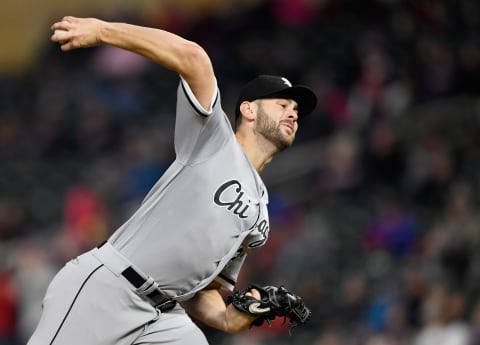
Chicago White Sox
The White Sox have been trending in the right direction from an organizational standpoint, but the results are finally reaching Guaranteed Rate Field. At 35-37 entering play on Thursday night, they remain 4 games back of the second Wild Card – the perfect distance to talk themselves into overreaching a year too soon.
Lucas Giolito‘s emergence as a frontline starter is a big reason the Southsiders hover around .500, but the rest of the rotation has been…lackluster. Ivan Nova (6.28 ERA) and Reynaldo Lopez (6.31 ERA) are the only other starters to take the hill at least ten times this year, and even Carlos Rodon‘s future viability as a starter is in question.
Strasburg would give shape to an actual major league rotation that could contend in the AL Central as early as next season, and there’s no doubt they have the pieces to get him. Michael Kopech might be a piece worth considering here, even with his injury, and though they aren’t likely to move Dylan Cease, they have a host of intriguing outfielders the Nationals might like to slide next to Robles and Soto.
The problem here, as will be the case with the next team on this list, is Strasburg’s contract. He has opt-outs after this season and next. A weighty $45MM fourth year and an uneven free agent market make it even odds as to whether he opts out, but there’s still a risk.
If he doesn’t opt out, the four years, $100MM is a fair price to pay for his age 32 to 35 seasons, and right in the neighborhood of what he could expect on the open market.
Still, those opt-outs make a move this season likely too risky for the Sox, as the ceiling for this season simply isn’t high enough to dip into their stable of promising youngsters.
Keep an eye out for Chicago in the offseason, but for now, they’re probably not ready to cash in.
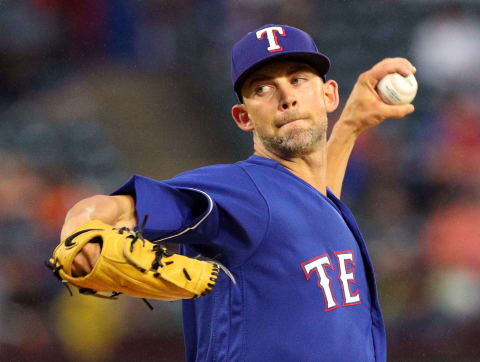
Texas Rangers
The Rangers are in a similar boat. A surprisingly positive 2019 puts buying on the table, but a Strasburg acquisition without a guarantee that he won’t opt out is just too risky a move just for a chance at the wild card, especially given the prospect cost it will take to get him.
On the other hand, the Rangers really have no rotation to speak of when it comes to 2020, and locking in Strasburg now would bolster their chances at contention then and now. Mike Minor and Lance Lynn are almost as likely to make a playoff start for another team in 2019 as they are the Rangers, but Strasburg and Minor would be a fun yin-and-yang pairing to front their future rotation.
Minor (6-4 2.63 ERA, 3.73 FIP, 3.09 K:BB) has one more year at a little under $10MM on his contract, which makes him an attractive trade piece this season. As with the White Sox, the Rangers are more likely to push the rebuild one more season and move Minor if they can net a near-ready starter from a contender (but that’s another slideshow altogether).
But unlike the White Sox, the Rangers are in playoff position now. If Jon Daniels thinks he can sell Strasburg on following Nolan Ryan’s legacy in their new ballpark in Texas, Strasburg might be the slide-stopper they need to hold the rest of the American League at bay.
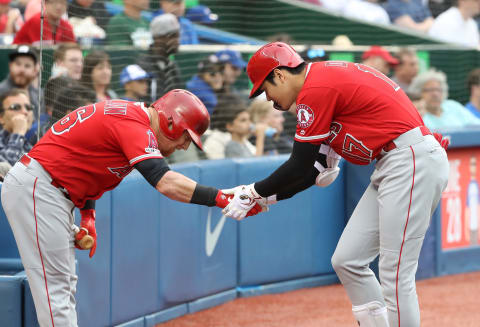
Los Angeles Angels
It is downright criminal that Billy Eppler and company have been unable to build a contender around Mike Trout. I know this is well-trod territory, but it’s just such an extraordinary bummer that it’s hard not to harp on it.
The A’s, Mariners, and Rangers have each managed at least an 89-win season since the Angels last finished above .500 (2015). The Astros, of course, are in a class by themselves, but they have something in common with the Rangers/Mariners/A’s: they don’t have the best player in baseball!
This season has brought more of the same: injuries, poor pitching, an otherworldly performance from Trout…and a record hovering around .500. That they uncovered two of the more unlikely breakouts in baseball this season in Brian Goodwin and Tommy La Stella only makes their mediocrity all the more infuriating.
Per usual, blame the pitching. The team owns the 4th-worst ERA in the AL (5.04 and the 3rd-worst FIP (4.97). Offseason acquisitions Matt Harvey, Trevor Cahill, and Cody Allen have been unmitigated failures, and while it’s nice that Griffin Canning is pitching well, they need starters. Both now and in the future (on and on forevermore, likely).
Unlike the Rangers and White Sox, the Angels should have no trouble convincing Strasburg to stay and front their rotation.
I will admit, this pairing is a bit cruel, as trading Strasburg to the Angels all but condemns him to a second Tommy John surgery – but it might be just crazy enough to work…

New York Yankees
Gross. I know. But if there’s an area of need for the Yankees, it’s the rotation. At the top, they’re okay: Masahiro Tanaka remains underrated and The Big Maple is as big and mapley as ever when healthy.
At the backend: not so much. J.A. Happ and CC Sabathia have plenty of name recognition, but not so much swing-and-miss at this stage of their respective careers. The American League will be a gauntlet once again, and as daunting at the Yankees offense is, the Twins and Astros can match them run-for-run.
Tanaka and Paxton compliment each other nicely, but add in Strasburg – a power righty – and then you’ve got a real Three Amigos thing happening.
For the Nationals, Clint Frazier is pissed about his recent demotion, and he’d be an explosive third wheel in right field alongside Juan Soto and Victor Robles. Adam Eaton could be moved to a contender or properly rested/platooned.
Frazier’s a hothead, for sure, but they could use some fire in Washington, where gameplay can oscillate between gleeful and moping (except on #Scherzday). Strasburg doesn’t like to be bothered – which isn’t the best quality for the New York media – but he wouldn’t be as big a focal point as he is in Washington either.
The Yankees have a slew of right-handed arms that might intrigue the Nationals, but Frazier’s presence here is not to be discounted. The Nats don’t have a ready replacement for Eaton in right, and by next season at the latest, they should be looking to get more pop out of that position.
Further, moving Strasburg over Scherzer makes sense in part because the Nationals don’t want to rebuild, and so long as Max fronts their rotation they’re going to be in the conversation. Getting an ML-ready and partially proven piece like Frazier will be appealing to Rizzo and company.
Remember, Scott Boras is Strasburg’s agent, and he could sway his client to opt out of his deal, especially if he thinks a team like the Yankees will be incentivized to tack an extra year or two on the end. That said, the Yankees have as good a chance as any team of convincing Strasburg to opt-in.
That is, as good as every team except one.
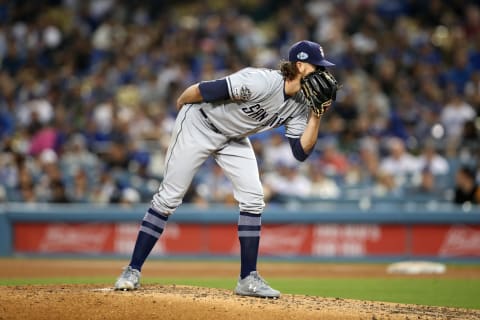
San Diego Padres
More from Call to the Pen
- Philadelphia Phillies, ready for a stretch run, bomb St. Louis Cardinals
- Philadelphia Phillies: The 4 players on the franchise’s Mount Rushmore
- Boston Red Sox fans should be upset over Mookie Betts’ comment
- Analyzing the Boston Red Sox trade for Dave Henderson and Spike Owen
- 2023 MLB postseason likely to have a strange look without Yankees, Red Sox, Cardinals
If the Nationals take my advice and trade Stephen Strasburg, the San Diego Padres should absolutely be their first call. Not only do they have the prospects to get him, but they’re a team on the cusp of contention with an outside shot at making this year’s playoffs.
They also happen to have a good collection of young pitchers without a veteran ace to front them. Who better to mentor Chris Paddack through a season with an imposed innings limit than the man who made the mold?
Outside of Manny Machado and Eric Hosmer, the Padres don’t have much in the way of future financial obligations, so they can add Strasburg’s yet-to-be-dispersed $100MM without any trouble.
But what the Padres have over every other team in baseball is a surefire pitch to convince Strasburg to stay. Remember, he has TWO opt-outs that could release him to free agency after 2019 or 2020, and any team moving significant prospect capital will want some security that he will stay long term.
For the Padres, this should be a lock. Not only would Strasburg be moving from a bandbox in Washington to the league’s most forgiving stadium in Petco Park, but he’s a hometown kid who played his college ball at San Diego State. He is beloved there. He loves to be beloved. It’s a perfect fit!
dark. Next. The Black Eye Game
The Padres aren’t going to want to deal from their plethora of top prospects, but if there’s a guy to go all-in for, it’s Scherzer…er, I mean Strasburg. It’s Strasburg.